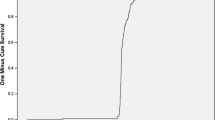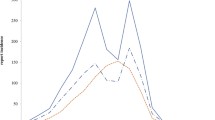Abstract
In Spain, measles, mumps and rubella vaccination was introduced in 1981, with one dose at the age of 15 months and another at the age of 11 years being administered since 1995. Reported disease incidence was less than one case per 100,000 people for measles and rubella, and 23 cases per 100,000 people for mumps. A seroepidemiological survey was undertaken to estimate the frequency of susceptible individuals by age and environment; and vaccination coverage and efficacy of the vaccines administered. A population-based cross-sectional study was then conducted, covering the population aged 2–39 years, residing in Spain (excluding Catalonia). The sample was stratified by age and rural/urban environment and informed consent obtained to take blood specimens from subjects attending blood-extraction centres. The final sample totalled 3932 persons. IgG antibodies were detected by an enzyme-linked immunosorbent assay. Estimated vaccination coverage was 96% for children aged 2–5 years; vaccine efficacies were 96.7% for measles, 97.2% for rubella and 79.3% for mumps. Immunity was the lowest in the 6–9 year age group for measles (90.8%) and in males aged between 15 and 24 years for rubella (86 and 89.8%, respectively). In the case of mumps, this proved the lowest in the 2–5 year age group (76.7%) and in those autonomous regions in which only the Rubini strain had been administered. The incidence of measles has enabled the National Measles Elimination Plan to be implemented by which the elimination of congenital rubella syndrome could now be initiated. A possible explanation for the higher susceptibility observed for mumps might lie in the Rubini strain's low efficacy.
Similar content being viewed by others
References
HEALTH 21: The health for all policy framework for the WHO European Region. European Health for All Series, no. 6,1999.
Grenfell BT, Anderson RM. The estimation of agerelated rates of infection from case notification and serological data. J Hyg Camb 1985; 95: 419–436.
Estado de las Enfermedades de Declaración Obligatoria. Bol Epidemiol Semanal. España 2000; 8(24): 270.
Bartlett MS. Measles periodicity and community size. J R Statist Soc A 1957; 120: 48–70.
Clarkson JA, Fine PEM. The efficiency of measles and pertussis notification in England and Wales. Int J Epidemiol 1985; 14: 153–168.
II Encuesta de Serovigilancia de la Comunidad Autónoma de Madrid. Documento Técnico de Salud Pública no. 29. Comunidad de Madrid. 1995.
Levy PS, Lemeshow S. Sampling of populations: Methods and Applications. New York: Wiley-Interscience, 1991.
Cochran WG. Sampling Techniques, 3rd ed. New York: Wiley, 1977.
Kish L. Survey Sampling. New York: Wiley-Interscience, 1995.
Shah BV, Barnwell BG, Bieler GS. SUDAAN User's Manual, Release 7.0. Research Triangle Park, NC: Research Triangle Institute. 1996.
Orenstein WA, Bernier RH, Hinman AR. Assessing vaccine efficacy in the field. Further observations. Epidemiol Rev 1988; 10: 212–241.
de Melker HE, Spaendonck C-V. Immunosurveillance and the evaluation of national immunization programmes: A population-based approach. Epidemio Infect 1998; 121: 637–643.
Osborne K, Gay N, Hesketh L, Morgan-Capner P, Miller E. Ten years of serological surveillance in England and Wales: Methods, results, implications and action. Int J Epidemiol 2000; 29: 362–368.
King GE, Marcowitz LE, Patriarca PA, Dales LG. Clinical Efficacy of measles vaccine during the 1990 measles epidemic. Pediatr Infect Dis J 1991; 10: 883–887.
Black FL, Berman LL, Libel M, et al. Inadequate immunity to measles in children vaccinated at an early age. Effect of revaccination. Bull World Health Organ 1984; 62: 315–319.
De-Serres G, Boulianne N, Meyer F, Ward BJ. Measles vaccine efficacy during an outbreak in a highly vaccinated population: Incremental increase in protection with age at vaccination up to 18 months. Epidemiol Infect 1995; 115(2): 315–323.
Janaskez W, Gut W, Gay NJ. The epidemiology of measles in Poland: Prevalence of measles virus antibodies in the population. Epidemiol Infect 2000; 125: 385–392.
Galazka AM, Robertson SE, Kraigher A. Mumps and mumps vaccine: A global review. Bull World Health Organ 1999; 77(1): 3–14.
Sullivan KM, Halpin TJ, Marks JS, Kim-Farley R. Effectiveness of Mumps Vaccine in a School Outbreak. AJDC 1985; 139: 909–912.
Hersh BS, Fine PEM, Kent WK, et al. Mumps outbreak in a highly vaccinated population. J Pediatr 1991; 119: 187–193.
Ward BJ, Boulianne N, Ratman S, Guiot MC, Couillard M, De Serres G. Cellular immunity in measles vaccine failure: Demonstration of measles antigenspecific lymphoproliferative responses despite limited serum antibody production after revaccination. J Infect Dis 1995; 172(6): 1591–1595.
World Health Organization. Measles. A strategic framework for the elimination of measles in the European Region. The Expanded Programme on Immunization in the European Region of WHO. Copenhagen 1999.
Cutts FT, et al. Control of rubella and congenital rubella syndrome (CRS) in developing countries, part 1: Burden of disease from CRS. Bull World Health Organization 1997; 75: 55–68.
Baum SG, Litman N. Mumps virus. In: Mandell GL, Bennetts JE, Dolin R (eds), Principles and Practice of Infectious Diseases, 5th ed. Churchill Livingston, 2000; 1776–1781.
Pons C, Pelayo T, Pachón I, et al. Two outbreaks of mumps in children vaccinated with the Rubini strain in Spain indicate low vaccine efficacy. Eurosurveillance 2000; 5: 80–84.
Fahlgren K. Two doses of MMR vaccine-sufficient to eradicate measles, mumps and rubella?. Scand J Soc Med 1988; 16: 129–135.
Cochi SL, Wharton M, Plotkin SA. Mumps vaccine. In: Plotkin SA, Mortimer EA Jr (eds) Vaccines, 2nd ed. Philadelphia, PA: WB Saunders, 1994; 277–301.
Gonçalves G, DE Araujo A, Montero Cardoso ML. Outbreak of mumps associated with poor vaccine efficacy-Oporto, Portugal, 1996. Eurosurveillance 1998; 3: 115–121.
Germann D, Ströhle A, Eggenberger K, Steiner CA, Mtter L. An outbreak of mumps in a population partially vaccinated with the Rubini strain. Scand J Infect Dis 1996; 28: 235–238.
Davidkin I, Valle M, Julkunem I. Persistence of antimumps virus antibodies after a two-dose MMR vaccination. A nine-year follow-up. Vaccine 1995; 13: 1617–1622.
Author information
Authors and Affiliations
Rights and permissions
About this article
Cite this article
Amela, C., Pachón, I. & de Ory, F. Evaluation of the measles, mumps and rubella immunisation programme in Spain by using a sero-epidemiological survey. Eur J Epidemiol 18, 71–79 (2003). https://doi.org/10.1023/A:1022567811765
Issue Date:
DOI: https://doi.org/10.1023/A:1022567811765




